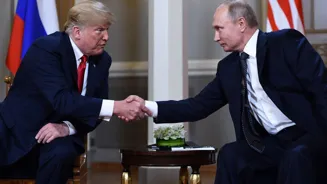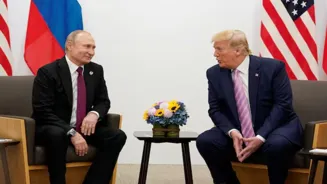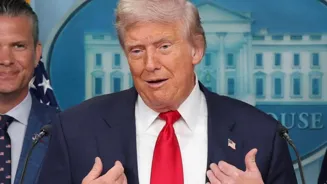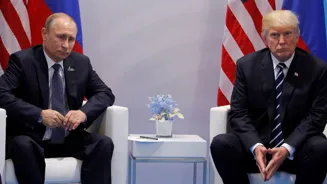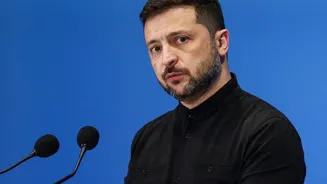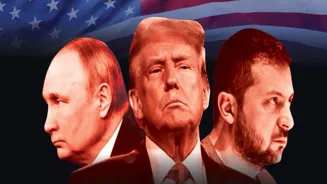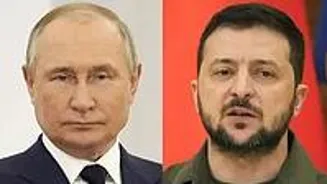The European countries have stood with Kyiv since the beginning of the Russia-Ukraine war in early 2022. For more than two years since the war, members of the North Atlantic Treaty Organisation (Nato), led by the US and the European
Union, were united in supporting Ukraine in its war efforts against its more powerful neighbour. Billions of dollars of military assistance, including weapons and ammunition, flowed into Ukraine.
However, divisions within Nato as well as between the US and the European Union have become more discernible with the return of Donald Trump to the American White House. President Trump, from the days of presidential election campaigns for the second term, has repeatedly opposed his predecessor Joe Biden’s Ukraine policy. He also drastically differed with
Biden’s approach to Nato. During his first presidency, Trump was distrustful of Nato, but his successor, Joe Biden, had restored the trans-Atlantic trust amidst the Ukraine War.
While President Trump in his second administration successfully bulldozed Nato members to agree to his proposal for enhancement of their defence expenditure to make it five per cent of their respective GDP, he has not been able to bully the EU member countries to endorse his policy towards Russia and its war against Ukraine.
As President Trump and his Russian counterpart Vladimir Putin are scheduled to meet in Alaska on Friday for their first summit this year and negotiate a deal to end the Ukraine War, European countries appear nervous. President Trump is not willing to carry the leaders of America’s trans-Atlantic allies along with him while negotiating with President Putin.
During decades of the Cold War, the US always consulted, partnered and collaborated with the European allies on numerous conflict spots. The US and Nato were
together in the longest war of the Cold War era in Vietnam. They were together too in the longest war of the post-Cold War era against the Taliban regime in Afghanistan. The US and the Nato members also fought against Russia by fully backing Ukraine militarily and seeking to cripple the Russian economy through sanctions during the Biden administration.
But now, under the Trump 2.0 administration, the trans-Atlantic relations have developed cracks, perhaps beyond complete restoration in the near future. Twenty-three
out of 27 members of the European Union are also members of the Nato alliance. President Trump considers the EU a fierce competitor, perhaps an economic rival, and recently launched a tariff war against them, as against numerous countries around the world.
After several rounds of negotiations, the EU managed to conclude a trade deal by agreeing to a 15 per cent tariff on their exports to the US, which is actually several times more than the tariff rate earlier. The EU as an association signed the deal; the details of the deal, however, are not
known. And all individual member countries are not contented over it. While many European leaders stay away from making critical remarks on President Trump’s policies, the French prime minister called it “a dark day” when the deal was announced. Others described it as a “suboptimal deal”.
While the EU energy imports from Russia were difficult amidst the Ukraine war and implementation of anti-Russian sanctions by the combined West, Trump’s demands for more defence expenditure added to the economic agonies of the EU. But the European
allies of the US felt more firmly sandwiched when Trump dilly-dallied on backing Ukraine militarily, pushed for direct negotiations with Russian President Putin and refused to consult them on an issue that has perceptibly posed the most serious security challenge to the continent since the end of the Second World War.
The decision of President Trump to hold a bilateral summit with President Putin in Alaska has rung an alarm bell in Europe. More outrageous to Ukraine and its European backers is the idea of a “land swap” as part of the
deal that would allow Russia to gain territory and make Ukraine cede part of its sovereign territory. Seven EU members, including France and Germany, issued a joint statement and proclaimed that “the path to peace in Ukraine cannot be decided without Ukraine”. Ukrainian President Vladimir Zelenskyy, on his part, outrightly rejected any “land swap” that would be decided by the American and Russian leaders on Ukrainian territory.
It appears as if in the current situation Ukraine and some European powers are
united against the United States and Russia! Its ramifications can be radical transformations in contemporary geopolitics. The trans-Atlantic alliance can develop holes that will be difficult to fill up in the foreseeable future. The divergences on political and security affairs between the United States and Europe appear stark when one considers the French and British position on Palestine, the Spanish and Swiss decision against buying F-35 fighter aircraft from the US and the European resolve to bolster their military capabilities to address security challenges in the absence of American support. France and Britain have proposed the idea of collaboration in developing a European deterrence capability.
It is understandable that there will be limits to US-Russia détente. Whether it will survive the Trump 2.0 administration is also a question mark. But the challenges of this détente between erstwhile cold warriors under the Trump administration may further erode the strategic trust between the United States and its European allies.
The EU and Britain seem to have embarked upon a
journey for achieving strategic independence from the United States, and this journey is unlikely to end even after a change of administration in the US.
However, the EU’s desire to achieve strategic autonomy is not going to be an easy way. The EU will also face tremendous difficulties from within the association. There are member countries that admire the Trumpian policies, and then there are also members, such as Poland, Hungary and Slovakia, which are Euro-sceptics. The recently elected president of Poland, Karol Nawrocki, for instance, is a right-wing
leader who appears to be pro-Trump on certain policy matters. He is dead against Russia but opposes Nato membership for Ukraine. Yet, the efforts towards consolidating the abilities of the EU to confront the challenges emanating from the other side of the Atlantic will remain a work in progress.
The author is founding chairperson, Kalinga Institute of Indo-Pacific Studies, and editor, India Quarterly. The views expressed in the above piece are personal and solely those of the author. They do not necessarily reflect
Firstpost’s views.